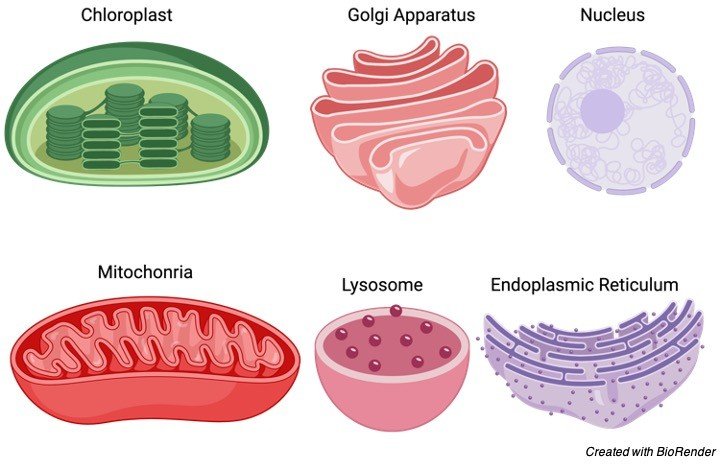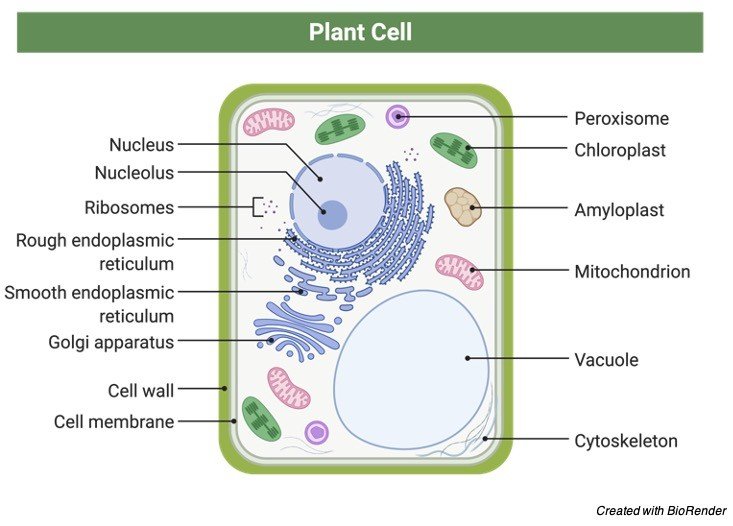Table of Contents
What is Cell Organelle?
Any of the numerous cellular structures that perform a specific job inside a cell is referred to as an organelle. All creatures have a cell that serves as their structural, functional, and biological unit. It is a membrane-bound structure that contains cytoplasmic compartments and structures. Eukaryotic cells and prokaryotic cells are distinguished by the presence of cytoplasmic membrane-bound organelles. A eukaryotic cell is defined by the presence of membrane-bound organelles, whereas a prokaryotic cell is defined by the absence of such organelles.

The nucleus, endoplasmic reticulum, Golgi apparatus, mitochondria, and plastids are all organelles bound by a double lipid bilayer in a eukaryotic cell. The plasma membrane and the cell wall are also included. Some sources classify single-membraned cytoplasmic structures such as lysosomes, endosomes, and vacuoles as organelles. The non-membrane-bound cytoplasmic structures, such as the nucleolus and ribosomes, are another less-strict definition of an organelle.
Cell Organelle Definition
Organelle literally translates to “little organs.” The cell, like the rest of the body, is made up of numerous organs that execute specific activities. They are membrane-bound compartments or structures of a cell in general. An organelle, by definition, is a membrane-bound compartment or structure in a cell that serves a specific purpose. In a broader sense, an organelle is any cellular structure that performs a specific function, whether or not it is membrane-bound.
Cell Organelle Etymology
The name organelle is derived from the New Latin organella, which is a diminutive of the Medieval Latin organum, which means “body organ.” Organellar is a derived term that means “pertaining to, related to, or characterised by an organelle.”
Cell Organelle vs Inclusions
The living components inside the cell are known as organelles. Cell inclusions, on the other hand, are non-living elements found inside the cell. The term “non-living” refers to the fact that the inclusions do not perform the biological functions that organelles do. Fat droplets, glycogen, and pigment granules, such as melanin, lipofuscin, and hemosiderin, are all included.
Eukaryotic vs Prokaryotic Organelle
The nucleus, endoplasmic reticulum, Golgi apparatus, mitochondria, and chloroplast are just a few of the organelles found in eukaryotic cells (plastids). Not all of these organelles, however, are located in a single cell or organism.
Plant cells, for example, have a lot of chloroplasts, while animal cells don’t. According to the endosymbiotic hypothesis, there are organelles that have their own DNA separate from the nucleus and are thought to have arisen from endosymbiotic bacteria. Mitochondria and plastids are the organelles in question.
Prokaryotes, which were previously thought to lack organelles, have lately been shown to have their own type of “organelle.” However, they are sometimes referred to as proteinaceous micro-compartments rather than genuine organelles in other sources. The Carboxysome (a protein-shell compartment in some bacteria for carbon fixation), chlorosome (a light collecting complex in green sulphur bacteria), magnetosome (found in magnetotactic bacteria), and thylakoid are examples (in some cyanobacteria).
Types of Cell Organelle
An organelle, according to some sources, is one that is surrounded by lipid bilayers. They include the nucleus, endoplasmic reticulum, Golgi apparatus, mitochondria, and plastids, according to this definition (e.g., chloroplasts). Ribosomes and nucleosomes are not considered organelles in this sense, since they are not confined by membranes. Similarly, because they are single-membrane confined cytoplasmic structures, lysosomes and vacuoles do not qualify as organelles.
Animal Cell Diagram

Other sources, on the other hand, are less restricted. An organelle is a specialised component of a cell that has a defined purpose. Organelles may be divided into two categories: membrane-bound organelles (which include both double-membraned and single-membraned cytoplasmic structures) and non-membrane-bound organelles (also referred to as biomolecular complexes or proteinaceous organelles).
Plant Cell Diagram

I. Membrane Bound Organelle
Membrane-bound organelles are cellular structures that have a biological membrane that binds them together. The membrane is generally made up of a single or double layer of lipids with interspersed proteins. The nucleus, endoplasmic reticulum, Golgi apparatus, mitochondria, plastids, lysosomes, and vacuoles are all membrane-bound organelles.
i. Nucleus
The nucleus is an organelle that regulates gene expression and is important for preserving DNA integrity as well as governing cellular functions such as metabolism, growth, and reproduction. Because of its relatively large size and usually spherical form, the nucleus is one of the most visible components in a cell. A nuclear envelope, which is a lipid bilayer perforated with nuclear pores, holds it together. However, some cells do not have a nucleus. At adulthood, red blood cells, for example, shed their nucleus to increase their affinity for respiratory gases like oxygen. Multiple linear DNA molecules are arranged into structures called chromosomes inside the nucleus.
ii. Endoplasmic Reticulum
The endoplasmic reticulum (ER) is a double-membrane organelle that is important for protein and lipid synthesis, glucose metabolism, drug detoxification, and intracellular transport, among other things. The rough ER and the smooth ER are the two kinds of ER. The surface of the rough ER is studded with ribosomes, whereas the smooth ER is devoid of bound ribosomes. Both kinds are made up of labyrinthine, interconnecting flattened sacs or tubules that run through the cytoplasm and may extend to the plasma membrane.
iii. Golgi Apparatus
The Golgi apparatus is a double-membraned organelle that is involved in glycosylation, secretion packing, lipid transit throughout the cell, and the formation of lysosomes. Membrane-bound stacks make up the structure.
iv. Mitochondria
Mitochondria (singular: mitochondrion) are double-membrane-bound spherical or rod-shaped organelles with their own genome, making them semi-autonomous. They are primarily responsible for the production of ATP via cellular respiration.
v. Plastids
Plant cells contain plastids, which are double-membrane-bound organelles found in photosynthetic cells. Chloroplasts, chromoplasts, and leucoplasts are the three kinds of plastids. Chloroplasts are photosynthesis-related plastids that contain green pigment. Chromoplasts are plastids that include colours other than green. Leucoplasts are pigment-free plastids that have a role in food storage.
vi. Lysosomes
Lysosomes are cytoplasmic organelles with a single membrane and a significant number of digesting enzymes. They have a single membrane and are largely responsible for the digestion and removal of extra or worn-out organelles, food particles, and ingested viruses or bacteria.
vii. Vacuoles
Vacuoles are membrane-bound vesicles in a cell’s cytoplasm, particularly in plants. They help with structural support, intracellular secretion, excretion, storage, and digestion, among other things.
viii. Endosomes
Endosomes are cytoplasmic structures with such a membrane that allow endocytosed molecules to pass through on their approach to the lysosome.
II. non-Membrane Bound Organelle
Organelles that are not membrane-bound yet perform specific tasks are known as non-membrane-bound organelles. Ribosomes, spliceosomes, vaults, proteasomes, DNA polymerase III holoenzyme, RNA polymerase II holoenzyme, photosystem I, ATP synthase, nucleosomes, centrioles, microtubule-organizing centres, cytoskeleton, flagellum, nucleolus, stress granules, and others are examples of non-membrane-bound organ
Cell Organelle Function
Each of the organelles has a particular function.
Nucleus: It is responsible for preserving DNA integrity and managing cellular functions such as metabolism, growth, and reproduction.
Mitochondrion: Through the process of cellular respiration, it is responsible for producing the majority of the cell’s adenosine triphosphate supply.
Plastids: Food storage and photosynthesis are two functions of this organ.
Endoplasmic Reticulum: Protein and lipid synthesis, glucose metabolism, calcium concentration, drug detoxification, receptor attachment to cell membrane proteins, and intracellular transport are all involved.
Golgi Apparatus: Glycosylation, packaging of molecules for secretion, lipid transport throughout the cell, and the formation of lysosomes are all functions of this protein.
Lysosomes: In particular, for digestion and the elimination of extra or worn-out organelles, food particles, and ingested viruses or germs.
Vacuole: Structure support, intracellular secretion, excretion, storage, and digesting are all functions of this protein.
Ribosome: Protein synthesis takes place here.
Nucleosome: The chromatin’s fundamental structural unit.
Centriole: Involved in the nuclear division process.
Cytoskeleton: It controls cell shape, maintains intracellular structure, and regulates cell mobility.
Cell Organelle Pathology
Nuclear genetic material is stored in the nucleus. Mutations in genes or chromosomes can have negative consequences or cause genetic diseases. Mutations in the mitochondria and chloroplasts’ extranuclear genetic material might also cause unhealthy or dysfunctional situations.
Lysosomal storage disease is a metabolic disorder caused by a malfunction in lysosomal function that results in an abnormal buildup of harmful chemicals in the cell. Lysosomal storage disorders are passed down through generations. The malfunctioning lysosomal enzyme is caused by a mutation in a specific faulty gene.
The nucleus is where genetic material is stored. Gene or chromosomal mutations can have severe repercussions or lead to genetic disorders. Mutations in the extranuclear genetic material of mitochondria and chloroplasts may potentially result in harmful or dysfunctional conditions.
A failure in lysosomal function causes an abnormal accumulation of toxic substances in the cell, resulting in lysosomal storage disease. Storage abnormalities of the lysosome are handed down through the generations. A mutation in a specific defective gene causes the lysosomal enzyme to fail.
Cell Organelle Citations
- Formation of plant cell wall supramolecular structure. Biochemistry (Mosc) . 2010 Feb;75(2):159-72.
- Plant cell wall-mediated immunity: cell wall changes trigger disease resistance responses. Plant J . 2018 Feb;93(4):614-636.
- How Bacteria Subvert Animal Cell Structure and Function. Annu Rev Cell Dev Biol . 2016 Oct 6;32:373-397.
- Shedding light on the cell biology of extracellular vesicles. Nat Rev Mol Cell Biol . 2018 Apr;19(4):213-228.
Share












